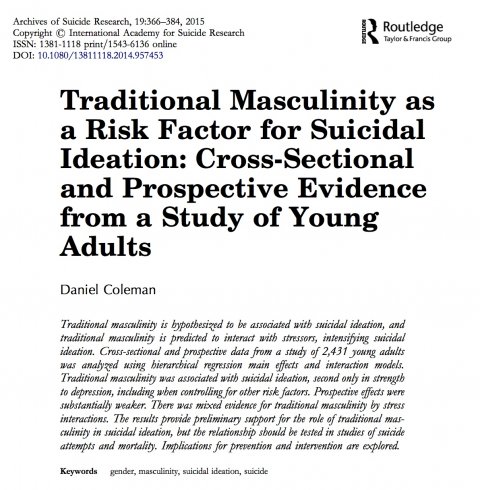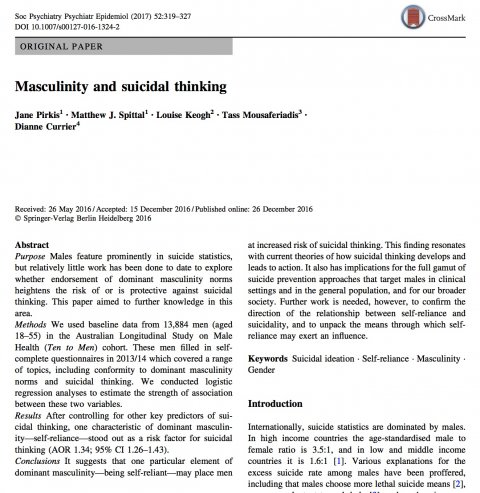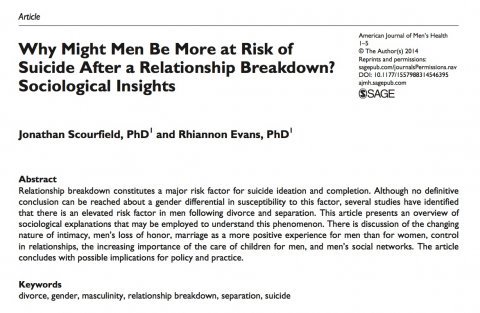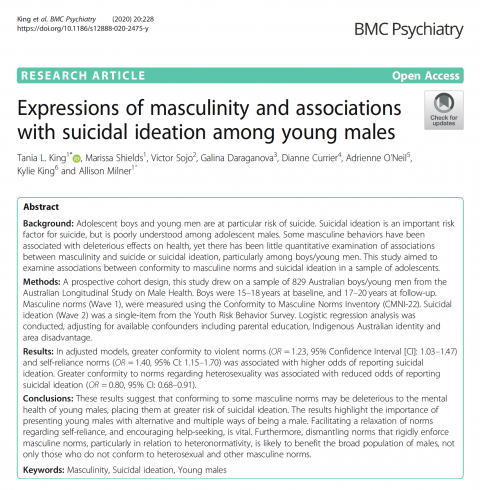



Males in high-income countries have rates of completed suicide several times those of females. Male suicide is shaped in part by constructions of masculinity – by men’s conformity to or agreement with specific stereotypically masculine norms – as a range of studies have documented. Here, we have collected key studies and reports on male suicide, in full text (PDF) below.
There is consistent evidence that conformity to stereotypical masculine norms is associated with both suicidal thoughts and suicidal behaviour:
- A recent systematic review on the role of masculinity in male suicide concludes, “Men who strongly conformed to the norms and values linked to traditional masculinity were more prone to die by suicide and to report experiencing suicidal thoughts and attempts” (Galvez-Sánchez, Camacho-Ruiz, Castelli, & Limiñana-Gras, 2024).
- In a qualitative metasynthesis and systematic review of 20 years of narratives both from men who are suicidal and from people who are bereaved by male suicide, there were associations between cultural norms of masculinity and suicide risk in 96% of studies (Bennett, Zortea, Dickson, & Richardson, 2023).
To highlight further studies;
- Traditional masculinity is an important predictor of suicidal thoughts in males. In a US cross-sectional study of 2,431 young adults, “Traditional masculinity was associated with suicidal ideation, second only in strength to depression, including when controlling for other risk factors” (Coleman, 2015).
- A national US study found that males with ‘high traditional masculinity’ (emotional restriction, competitiveness, aggression, etc.) were 2.4 as likely to die by suicide than non-HTM men. This is the first study to examine the influence of stereotypical masculine norms on actual suicide deaths (Coleman, Feigelman, & Rosen, 2020).
- Another study finds that men who endorse traditional masculinity, especially self-reliance, are more likely to have suicidal thoughts (Pirkis et al. 2017). In an Australian study among 13,884 men, after controlling for other key predictors of suicidal thinking, one characteristic of dominant masculinity – self-reliance – stood out as a risk factor for suicidal thinking.
- A study among young Irish men found they experienced high levels of emotional pain but had problems identifying symptoms and disclosing distress. Prevailing norms of masculinity discouraged disclosing distress and seeking help, so they opted for suicide (Cleary, 2012).
- In an Australian survey of 1,000 men aged 18 to 30, the ‘Man Box’ survey, young men with higher levels of conformity to stereotypical masculine norms were twice as likely as other young men to have considered suicide. They were more likely to report symptoms associated with poor mental health such as reporting ‘feeling down, depresssed, or hopeless’, and twice as likely to report having thoughts of suicide in the past two weeks (The Men’s Project & Flood, 2018, pp. 26-27).
- In a repeat of this ‘Man Box’ survey in 2024, again, men with higher levels of conformity to stereotypical masculine norms were considerably more likely than other men to have considered suicide (The Men’s Project & Flood, 2024, p. 90).
- A study among 829 Australian boys and young men found that conforming to some masculine norms is bad for the mental health of some adolescent males, placing them at greater risk of suicidal ideation. Higher conformity to norm of self-reliance was associated with suicidal thoughts (King et al., 2020).
- A report by the Samaritans on male suicide notes that masculinity – the way men are brought up to behave and the roles and behaviours expected of them – contributes to suicide in men (Whyllie et al.).
More on sex ratios for suicide: Rates of male suicide are significantly higher than female suicide particularly in high-income countries, but the sex ratio varies substantially across countries in regions. In high-income countries, the ratio of male:female suicide is 3.5, that is, with 3.5 male suicides for every female suicide. But in low- and middle-income countries, the ratio is 1.6 (World Health Organization, 2014, p. 20). The sex ratio for suicide is close to 1:1, or even lower for males than females, in some countries.
The full text pieces are as follows. Also see the academic references listed here: http://www.xyonline.net/content/g-suicide. Additions are most welcome.
- Adinkrah, M. (2012). Better dead than dishonored: Masculinity and male suicidal behavior in contemporary Ghana. Social science & medicine, 74(4), 474-481.
- Alston, M. (2012). Rural male suicide in Australia. Social Science & Medicine, 74(4), 515-522
- Bennett, S., Robb, K. A., Zortea, T. C., Dickson, A., Richardson, C., & O'Connor, R. C. (2023). Male suicide risk and recovery factors: A systematic review and qualitative metasynthesis of two decades of research. Psychological Bulletin, 149(7-8).
- Canetto, S. S., & Cleary, A. (2012). Men, masculinities and suicidal behaviour. Social Science & Medicine, 4(74), 461-465.
- Canetto, Silvia Sara. (2017). Suicide: Why are older men so vulnerable?. Men and Masculinities, 20(1), 49-70.
- Cleary, A. (2012). Suicidal action, emotional expression, and the performance of masculinities. Social Science & Medicine, 74(4), 498-505
- Coleman, D. (2015). Traditional Masculinity as a Risk Factor for Suicidal Ideation: Cross-Sectional and Prospective Evidence from a Study of Young Adults. Archives of Suicide Research, 19(3), 366-384.
- Coleman, D., Feigelman, W., & Rosen, Z. (2020). Association of high traditional masculinity and risk of suicide death: Secondary analysis of the Add health study. JAMA psychiatry, 77(4), 435-437.
- Flood, M. (2007) Suicide. In The International Encyclopedia of Men and Masculinities. Ed. M. Flood, J.K. Gardiner, B. Pease, and K. Pringle. Taylor & Francis.
- Galvez-Sánchez, C. M., Camacho-Ruiz, J. A., Castelli, L., & Limiñana-Gras, R. M. (2024). Exploring the Role of Masculinity in Male Suicide: A Systematic Review. Psychiatry International, 6(1), 2.
- King, T. L., Shields, M., Sojo, V., Daraganova, G., Currier, D., O’Neil, A., ... & Milner, A. (2020). Expressions of masculinity and associations with suicidal ideation among young males. BMC psychiatry, 20, 1-10.
- Kõlves, K., E-K. Kumpula, And D. De Leo. (2007). Suicidal behaviours in men: determinants and prevention in Australia. Brisbane: Australian Institute for Suicide Research and Prevention
- Mac an Ghaill, M. and Haywood, C. (2012) Understanding Boys: Thinking through boys, masculinity and suicide. Social Science and Medicine, 74(4): 482-89.
- Möller-Leimkühler, A.M. (2003). The gender gap in suicide and premature death or: why are men so vulnerable?European Archives of Psychiatry and Clinical Neuroscience, 253(1): 1-8.
- Oliffe, J. L., Ogrodniczuk, J. S., Bottorff, J. L., Johnson, J. L., & Hoyak, K. (2012). “You feel like you can’t live anymore”: Suicide from the perspectives of Canadian men who experience depression. Social Science & Medicine, 74, 506–514.
- Pirkis, J., King, K., Rice, S., Seidler, Z., Leckning, B., Oliffe, J. L., Vella, S., & Schlichthorst, M. (2023). Preventing Suicide in Boys and Men. In M. Pompili (Ed.), Suicide Risk Assessment and Prevention (pp. 483-494). Springer.
- Pirkis, Jane, Matthew J. Spittal, Louise Keogh, Tass Mousaferiadis, and Dianne Currier. (2017). Masculinity and suicidal thinking. Social Psychiatry and Psychiatric Epidemiology 52, no. 3: 319-327
- Pitman, A., Krysinska, K., Osborn, D., & King, M. (2012). Suicide in young men. The Lancet, 379, 2383–2392.
- Russell, S. T., & Toomey, R. B. (2012). Men’s sexual orientation and suicide: Evidence for US adolescent-specific risk. Social Science & Medicine, 74(4), 523-529
- Scourfield, J., & Evans, R. (2014). Why might men be more at risk of suicide after a relationship breakdown? Sociological insights. American Journal of Men’s Health, 9(5): 380-84.
- The Men’s Project, & Flood, M. (2018). The Man Box: A Study on Being a Young Man in Australia. Melbourne: Jesuit Social Services.
- World Health Organization. (2014). Preventing suicide: A global imperative: World Health Organization.
- Wyllie, Clare et al. (n.d.).Men, Suicide and Society. Surrey, UK: Samaritans.